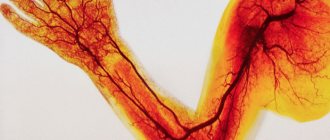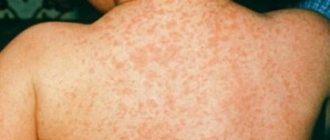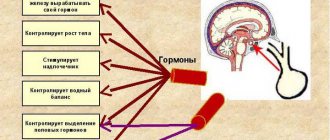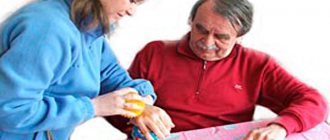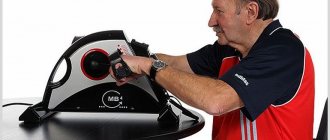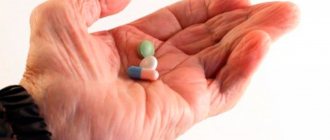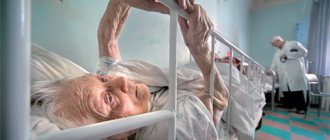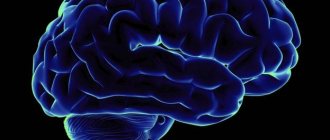A disruption of blood flow to the brain caused by a blockage or hemorrhage is called a stroke. When struck, part of the brain suffers from a lack of oxygen and nutrition, which causes serious problems.
If we talk about the fairer sex, the symptoms and first signs of stroke and micro-stroke in women can appear after 60 years. The course of the disease is much more complex than in men. It is also characteristic that women with low stress resistance, as well as those whose mood often changes, are more susceptible to the disease.
What are the signs of stroke in women? The first signs of a stroke in the stronger sex appear much earlier - a brain stroke can be diagnosed in a 40-year-old man. It is also important to take into account the fact that death due to stroke in women is diagnosed much more often. Even small deviations in well-being cannot be ignored, especially those that are similar to the symptoms of ischemic stroke or micro-stroke in women. If you learn to identify the symptoms of a cerebral stroke in women, this will allow you to seek help from a specialist in time and prevent possible serious problems.
Basic information
A stroke is an acute disturbance of blood circulation in the human brain, which causes the death of brain tissue. Modern medicine considers stroke (apoplexy) as a severe and dangerous lesion of the body’s nervous system.
The human brain, like all other organs of the body, needs arterial blood enriched with oxygen. When the blood vessels of the brain are damaged or blocked, it is actually left without much-needed nutrition and reacts to this condition by the death of a certain area. Together with the dead brain cells, a person loses the functions for which they were responsible. Moreover, the larger the area of damage to brain cells, the more serious the consequences of this condition for a person.
Features of stroke in women
The more stress, anxiety and pressure changes you have, the more likely it is that a stroke will happen to you at the most unexpected moment.
This is due to structural and physiological features. Therefore, even pregnant girls, due to the heavy load on the body, are faced with this disease.
try to smile (if the smile is crooked or one corner is lower than the other, then the attack has already occurred), raise two hands up at the same time (one of them will move to the side if a stroke occurs), try to say a simple phrase out loud (if this does not work or confusion arises, then you can call an ambulance).
In this case, general symptoms appear on the opposite side from the occurrence of lesions in the brain.
Traditional signs of a stroke can most accurately indicate the onset of an attack, as they show clear disturbances in brain activity. These include:
- problems with coordination and walking
- dizziness and severe headaches
- problems with speech and pronunciation
- vision problems
- limb paralysis or numbness
- general weakened state
Although traditional signs will indicate the onset of a stroke, they are considered the most dangerous.
If we talk about less common and non-traditional signs of a stroke, then they include numbness of the face, mental seizures, vomiting, and loss of orientation in space. This is most often not paid attention to, although it also indicates a health problem. Therefore, at the slightest manifestation, you must immediately consult a doctor and undergo a full course of examination. Sometimes this saves health and life.
Signs of ischemic stroke in women are considered the most universal and noticeable. Because in this state, brain cells begin to starve due to lack of oxygen. This happens in both the right and left areas of the brain. Although sometimes you can encounter complete damage to the cerebral cortex. And because of this, psycho-emotional processes and all motor functions suffer. That’s why the list of signs is the most extensive:
- loss of speech
- increase in pressure
- headache
- numbness of limbs and paralysis
- vision problems
- loss of consciousness and headache
Sometimes mild discomfort may appear a few days before the stroke, but this is worth paying attention to. Especially if you have recently been exposed to stress or heavy physical activity or are pregnant.
If we talk about hemorrhagic stroke, it happens much less frequently, but is more dangerous. Since not only blockage or thrombosis of blood vessels occurs, but their complete rupture and penetration of red blood cells through the walls of the heart. This process is irreversible and only progresses over time. Often patients in this state fall into a coma or die. The main signs of hemorrhagic stroke are:
- increased blood pressure
- headache, loss of orientation in space
- vomit
- heartache
- problems while walking
- partial loss of vision
- paralysis
In case of hemorrhagic stroke, it is especially important to immediately identify signs or predisposition in order to consult a doctor in time, take medication or go to hospital. Otherwise, a stroke in the acute phase can cause unpredictable harm to health, and the consequences can be especially complex.
If you detect the first signs of a stroke or the possibility of its occurrence, you should immediately go to the hospital and not self-medicate. The doctor will conduct an external examination, offer blood and urine tests, a tomography and cardiogram, and an ultrasound of the internal organs. Based on the results, a conclusion will be made and a treatment program will be prescribed.
If a situation happens to you or your loved one where a stroke does occur, you need to immediately provide first aid. First, call an ambulance, and then try to make the attack less painful. To do this, open the doors or windows to allow fresh air to enter, unbutton the woman’s blouse for normal oxygen flow, turn her head to the side when gagging occurs, place the patient in a lying position, but so that the shoulders are slightly above the head by about 30 degrees.
It is important to recognize the problem in time. The sooner help is provided, the more effective the treatment and recovery will be. No later than 4-6 hours after the first signs of pathology appear, it is necessary to restore blood circulation. If this is not done, the consequences can be severe and even fatal.
Poor circulation occurs suddenly, and it is impossible to prepare for its occurrence. But its onset can be determined by characteristic signs, and most manifest themselves in the same way in both hemorrhagic and ischemic stroke. The disease is characterized by the following symptoms:
- Unexpected weakness, numbness of the limbs on one side and half of the face.
- Paralysis of half the body.
- Dizziness, headache.
- Violation of muscle tone, loss of coordination.
- Nausea and vomiting.
- Difficulty or loss of hearing and speech, the appearance of “spots” before the eyes, temporary loss of vision.
Most often, the manifestation of several symptoms at the same time is recorded.
The development of any disease can be determined by the appearance of the first symptoms. Precursors of stroke in men can occur several hours or days before the attack. The approaching first signs of stroke in men are indicated by frequent sudden headaches, dizziness, and nausea. In addition, unfounded attacks of weakness may occur, and mood may change dramatically.
Among the first signs of stroke in men are often:
- Rare pulse.
- Numbness of the limbs on one side.
- Sweating.
- Impaired hearing and vision, speech and coordination of movements.
- Blurred consciousness.
The first signs of a pre-stroke condition do not appear for long and disappear over time. If they occur, you need to visit a doctor and undergo the necessary examinations. This will help prevent further progression of the disease and the development of complications.
The occurrence of a stroke is accompanied by severe headache and weakness. Over time, the following symptoms of stroke appear in men:
- Nausea and vomiting.
- Slowing heart rate.
- Deterioration of vision, impaired coordination of movements and orientation in space.
- Decreased sensitivity, impaired or complete loss of speech.
- Increased sweating.
- Redness of the face caused by frequent flushes of blood.
- Involuntary bowel movements or urination.
In rare cases, seizures, fainting, and even coma may occur during an attack. Certain symptoms of stroke in men can manifest with varying intensity. At the same time, men's symptoms are somewhat different from women's. A simple test helps determine the development of pathology. The patient should be asked to smile, speak and raise his hands, and then analyze these actions.
The smile of a person with a stroke will be asymmetrical: the corner of the lips will be raised on one side and lowered on the other. When speaking, the patient will experience difficulty reproducing and understanding speech. In addition, when trying to raise the arms, one will move more slowly and the patient will not be able to hold it in this position.
The symptoms of an impending stroke and the physiological criteria for its occurrence differ from those in men. In women, the disease is characterized by a more severe manifestation with pronounced consequences. Most often, a sudden circulatory disorder begins against a background of progressive deterioration of the condition. Precursors of a stroke in a woman manifest themselves as oxygen deprivation, increased blood pressure, and impaired blood flow in the brain. The first signs of a stroke in women are:
- Dizziness, headaches, feeling of heaviness, noise in the head.
- Violation of visual and auditory functions.
- Attacks of forgetfulness, absent-mindedness.
- Speech impairment, retardation.
- Numbness of the limbs and face, often occurring on one side.
- Poor coordination of movements, unsteady gait, awkwardness.
The disease is dangerous because the signs of an impending stroke cannot always be tracked and assessed. To confirm the presence of the first pathological signs in a woman, it is necessary to conduct a rapid test. If you suspect a pre-stroke condition in a woman, you need to ask her:
- Say something or repeat something that has already been said. At this point, speaking ability and articulation should be assessed.
- Smile. A large number of muscles are involved in producing a smile. During a stroke, only part of the face will change position.
- Raise your hands and hold them in this position. Muscle weakness at the first sign of illness will prevent you from performing this exercise correctly.
- Show tongue. Its deviation from a straight line is the first symptom of a stroke in a woman.
The hemorrhagic type is caused by other causes of stroke in women. It occurs as a result of a sudden rupture of an arterial vessel and has a different clinical picture. The following symptoms appear before a stroke in women:
- Partial paralysis of the face and limbs.
- Redness of the face as a result of a sudden rush of blood to the scalp.
- Difficulty breathing, shortness of breath.
- Decreased heart rate, pain in the heart area.
- Speech impairment.
- Photophobia.
- Strong thirst, feeling of dryness in the mouth.
- Strong headache.
At the first signs of a stroke, the patient must be hospitalized. Only in a hospital setting will she be able to receive effective treatment. While waiting for an ambulance, everything must be done to alleviate the patient’s condition. First of all, it should be laid down. If vomiting begins, turn your head to the side to ensure unimpeded exit of vomit.
- Strong headache;
- rapid deterioration in vision sharpness;
- uncontrollable vomiting;
- violation of movement coordination;
- asymmetry of facial expressions.
- Stroke in women usually occurs later. The average age of a male patient with this disease is 40 years. For a woman, this figure increases to 60 years.
- Pregnant women are at risk. When you are pregnant, your blood becomes thicker. A high number of abortions or pregnancy complications increase the risk of developing the disease throughout your life.
- Oral contraceptives also increase the risk of getting sick. This is due to their side effect - blood thickening and is especially dangerous after the age of 40.
- There is a certain “risk age” - from 18 to 35 years. Despite the fact that the average age of the patient is 60 years, young women taking contraceptives or having a difficult pregnancy should treat their health with attention.
- The first symptoms in women are more pronounced than in men. However, women more often ignore their presence.
- Often in the fair sex, the disease manifests itself in an atypical way.
- Women experience the disease more severely and are more likely to remain disabled. For them, in most cases it ends in death.
- Typically female traits - instability to stress, increased emotionality - can provoke the disease.
Main types of stroke
The two most common types of stroke are known - hemorrhagic, which develops when blood vessels rupture, resulting in hemorrhage into the ventricles of the brain and under its membranes, and ischemic, which occurs during prolonged spasm of blood vessels or blockage of their lumen by a blood clot. According to statistics, ischemic stroke is much more common and accounts for approximately 80% of all diagnosed cases.
A hemorrhagic stroke is essentially a cerebral hemorrhage that most often occurs in people suffering from high blood pressure. In most cases, this pathology develops against the background of a so-called hypertensive crisis. In some cases, an aneurysm, a congenital or acquired change in the walls of blood vessels in the brain, can provoke a hemorrhagic form of stroke. In this case, unable to withstand the pressure on the wall, the vessel ruptures. Very often, this form of stroke requires urgent surgical intervention.
An ischemic stroke is a brain injury that develops when a blood vessel is blocked by a blood clot. Most often, this disorder occurs with atherosclerosis, hypertension and/or atrial fibrillation. With the development of an ischemic stroke, the walls of the vessel remain intact, but the blood flow through it stops.
Types of stroke
There are 2 main types of stroke:
- hemorrhagic;
- ischemic.
Hemorrhagic
It occurs as a result of a rupture of the vessel wall, which leads to the destruction of brain cells, increased pressure on it, and spasms in other blood vessels, which can also lead to serious complications.
In turn, hemorrhagic stroke is divided into:
- hematoma;
- hemorrhagic permeation of the brain substance;
- subarachnoid hemorrhage.
Brain hematoma is observed in 85% of patients who died from hemorrhagic stroke. In this condition, pronounced changes in the walls of arterioles and small arteries are observed in the affected area with the formation of microaneurysms and rupture of their walls. At the site of the hemorrhage, destroyed brain tissue is found with the formation of a cavity filled with a granular mass - detritus of brain tissue (a product of cell breakdown) and blood clots. All of the above signs are elements of red softening of the brain.
Typically, hemorrhages are localized in:
- cerebellum;
- optic tubercle;
- internal capsule;
- other subcortical structures of the brain.
The size of the hematoma can vary.
In rare cases, hemorrhage is observed, covering the entire mass of subcortical structures, with a breakthrough into the lateral, third and fourth ventricles of the brain, which ends with leakage in the region of the base of the brain.
Hemorrhagic permeation of the brain substance is a type of stroke in which small confluent foci of hemorrhage are detected. Among the blood-soaked brain matter, nerve cells with necrobiotic changes are identified. The most characteristic places for the pathological process:
- visual hillocks;
- pons.
The cerebral cortex and cerebellum suffer from hemorrhagic impregnation extremely rarely.
Ischemic
Also known as cerebral infarction. This is the most common form of stroke, occurring in 80% of cases. Pathogenetically divided into:
- Atherothrombotic stroke. The cause of occurrence is atherosclerosis of cerebral arteries of large or medium caliber. This type of cerebral infarction is characterized by gradual development, with symptoms increasing over the course of hours or days. The onset of the pathological condition may occur during sleep. The pathological focus comes in different sizes.
- Cardioembolic stroke. Complete or partial blockage of a cerebral artery by an embolus is the cause of the development of this pathogenetic form of the disease. It begins acutely, more often during the day while awake. The middle cerebral artery is usually affected, and the areas of the brain that it supplies are susceptible to ischemia. Medium and large affected areas predominate.
- Hemodynamic stroke. It can be caused by a decrease in blood pressure (including physiological hypotension that occurs during sleep, and pathological hypotension - with hypovolemia, orthostatic collapse) or a drop in cardiac output, which occurs with coronary heart disease, a significant decrease in heart rate. The affected area can vary in size, usually affecting the cortical and periventricular areas of the blood supply.
- Lacunar stroke. Develops as a result of damage to perforating arteries. Lacunar stroke is characterized by gradual development over several hours with lesions no more than 1.5 cm in diameter. The basal ganglia, internal capsule, white matter of the centrum semiovale, and the base of the pons are affected. The presence of focal symptoms is noted in accordance with the affected area of the brain in the absence of meningeal and cerebral symptoms.
- Rheological stroke (or stroke of the hemorheological occlusion type). The pathology is based on fibrinolytic and hemostatic disorders. The clinical picture is dominated by manifestations of hemorheological pathologies and mild neurological symptoms.
Depending on how quickly the neurological deficit is formed and how long it lasts, there are:
- Transient ischemic attacks are pathological processes that regress within 24 hours from the moment of development. Clinical manifestations include focal neurological disorders (patients often exhibit monocular blindness or blindness in one eye).
- “Minor stroke” is a prolonged ischemic attack with a reverse neurological defect. Recovery of the latter is observed within 2-21 days.
- Progressive ischemic stroke , according to the name, is characterized by a gradual increase in cerebral and focal symptoms over several hours or days. Functions are not fully restored, and the patient may experience neurological symptoms in the future.
- Total ischemic stroke is a formed cerebral infarction in which a stable or partially regressive deficit is observed.
During a microscopic examination of an ischemic infarction, specialists often find dead neurons among the necrotic masses.
Causes of stroke
The main risk factors that can trigger a stroke include:
- smoking;
- atrial fibrillation;
- constant stress;
- alcohol abuse;
- low physical activity;
- elevated cholesterol levels;
- atherosclerosis;
- obesity;
- high blood pressure.
It is clear that the presence of individual or several predisposing factors does not guarantee the development of a stroke, but in most cases they contribute to the development of such a disorder. This is why it is so important to reduce their number to a minimum. Of course, a person is simply unable to change some of these factors, but much related to the correction of blood pressure levels, lifestyle and complete cessation of bad habits is quite possible.
Main symptoms (signs) of stroke
Most often, a stroke occurs late at night or early in the morning. The first signs of this violation include:
- sudden numbness or muscle weakness in the limbs or face, particularly on one side of the body;
- sudden deterioration of vision in one or both eyes;
- sudden and sharp causeless headache;
- unexpected difficulties in the perception of text or speech, articulation;
- dizziness, sudden disruption of normal coordination of movements, unsteadiness of gait.
Typically, such signs appear against the background of high blood pressure. If someone around you has such symptoms, you must immediately call an ambulance, since in this case, delay can lead to very serious problems and even death. When calling doctors, it is necessary to accurately describe to the dispatcher everything that happened so that a specialized neurological team can immediately go to the scene.
Until the doctors arrive, you need to lay the patient down, providing him with an influx of fresh air and complete rest. When a patient with a stroke enters the clinic, specialists immediately assess respiratory and cardiac activity, and also provide him with the necessary urgent care. If necessary, the patient can be immediately referred to a specialized department.
Main symptoms of the disease
Stroke in women is characterized by the presence of certain symptoms. Patients report the occurrence of severe headaches, which are characterized by the absence of relevant causes. The facial muscles become excessively weak, which causes pathology. The patient may have numbness in the upper and lower limbs on one side . A woman cannot gesture.
A stroke is accompanied by disorientation and impaired coordination of movements. The patient may suddenly lose balance. The disease is accompanied by the appearance of seizures. The swallowing process is disrupted in patients. After an attack, hiccups, nausea, and vomiting are diagnosed. The patient may experience severe dizziness, after which she falls. Stroke is accompanied by depression. A woman cannot control her emotions.
A stroke attack is accompanied by a short-term loss of consciousness. The patient experiences increased breathing, facial flushing, lack of pupillary response to light, and low pulse. With pathology, patients develop photophobia. When eating liquid food, it flows out of the woman’s mouth.
The signs of stroke in women over 50 are pronounced, therefore, when pathology appears, the patient is recommended to provide first aid and prescribe effective treatment, which will guarantee a favorable prognosis.
Diagnosis of the disorder
The primary task of doctors in case of a stroke is to determine its type. To do this, an MRI (magnetic resonance imaging) of the brain is performed, which makes it possible to distinguish an ischemic stroke from a hemorrhagic one. In addition, such an analysis makes it possible to exclude other possible diseases and accurately determine the location and extent of brain damage.
When diagnosing an ischemic stroke, an ultrasound examination of the vessels of the brain and neck is performed, which includes duplex scanning, echocardiography and cerebral angiography. It may also be necessary to conduct so-called Holter monitoring - recording an electrocardiogram throughout the day.
If research has established the presence of a hemorrhagic stroke, doctors perform cerebral angiography and Doppler scanning of the brain vessels to determine the exact cause of the hemorrhage. Often in this case, the patient requires consultation with a neurosurgeon.
Treatment of stroke: main stages
The most important thing in this case is that assistance to the patient begins immediately after the onset of stroke symptoms. New therapeutic approaches are effective only in cases where they were used within a few hours after apoplexy. For example, the administration of a drug that dissolves blood clots in the brain vessels should be carried out no later than three hours after the occurrence of the disorder.
After a diagnostic examination has made it possible to accurately determine the type of stroke, the specialist selects the most optimal treatment approaches. The main goal in this case is to prevent the progression of brain cell damage. If a stroke occurs due to circulatory problems, complex therapy may include:
- Tissue plasminogen activator is a drug that can “dissolve” a blood clot, effective only when administered within three hours after the onset of a stroke;
- Medications that prevent blood clotting - anticoagulants and antiplatelet substances;
- A surgical intervention during which the normal lumen of the narrowed carotid artery is restored.
When the cause of a stroke is hemorrhage, complex therapy may include:
- drugs that restore normal blood clotting ability;
- blockade of a damaged vessel by introducing a special spiral into it;
- drugs that prevent edema and swelling of the brain;
- surgery to remove blood or relieve pressure on the brain;
- surgery to restore a damaged vessel wall;
- insertion of a special tube into the ventricle of the brain, which releases excess fluid and reduces intracranial pressure.
After a stroke, the patient may still have severe functional impairment – a certain degree of disability. The severity of brain dysfunction depends on the location and size of the damaged areas. Thus, the right side of the brain controls the left side of the body, and in right-handed people, in addition, it also plays a critical role in the skills of spatial-visual perception and attention. The left hemisphere of the brain is responsible for controlling the right half of the body, and in 50% of left- and right-handed people it also controls speech functions - the ability to understand speech and speak.
How to recognize a stroke in another person?
If you notice an unexpected deterioration in your relative's health, ask him to perform a few simple tests:
- Ask the person to smile. If he has a stroke, he will not be able to do this. One side of the face will break into a smile, while the other will remain relaxed. Which side will droop depends on which hemisphere of the brain was affected by the stroke. If the pathology affects the right hemisphere, the facial muscles on the left side of the face fail, and if the left hemisphere fails, vice versa.
- Ask the person to stick out their tongue. The patient will also not be able to stick it out completely. It will be bent in one direction.
- Ask the person some basic question: what did he eat today, what did he do today, what day is it today. When answering, you will immediately see speech difficulties caused by weakening of the muscles of the organs of articulation. Sometimes, with a brain stroke, thinking disorders also appear. They can also be noticed when a person answers a simple question. You can also ask the person to repeat a simple tongue twister after you.
- Ask to raise both hands up. If the right side of the brain is affected by a stroke, a person will not be able to raise his left arm, but if the left hemisphere is affected, he will not be able to raise his right arm.
Stroke recognition test
If a person cannot complete at least one of the listed tasks, call him an ambulance immediately!
Rehabilitation measures after a stroke
In this case, rehabilitation measures help restore those brain functions that were lost by a person due to a stroke. As part of rehabilitation, most patients experience improvement, expressed to varying degrees. However, even after active rehabilitation, many patients cannot fully establish the lost functions.
Unlike other cells in the body, dead nerve cells are not replaced by new ones. But the human brain has enormous adaptability, and patients can achieve significant improvements by “forcing” living brain cells that were not damaged by a stroke to work.
The rehabilitation period can be quite difficult for the patient. In such a situation, the patient and his loved ones should work to restore lost functionality together with a medical team that includes not only doctors and nurses, but also speech and occupational therapists. Improvement, if possible, usually occurs within the first six months of the rehabilitation process. However, in some patients after apoplexy, improvement may occur after a longer period of time.
Possible consequences of a stroke
Essentially, there are three possible course of a stroke:
- favorable, in which the patient’s consciousness is restored literally in a couple of minutes or hours;
- intermittent, which is characterized by periods of “enlightenment” of consciousness;
- progressively severe, during which consciousness returns to the patient only after 3 or more days.
If the course of a stroke is favorable, then with proper and timely treatment it is possible to restore almost all impaired functions of damaged brain tissue in full; with an intermittent type of stroke, recovery is possible for most of the disorders, but there is a possibility of repeated apoplexy and the addition of additional pathologies - pneumonia or heart disease. A progressively severe stroke is accompanied by a gradual increase in symptoms and often ends in death.
As for the typical consequences of a stroke, neurological disorders include defects or complete loss of speech, hearing and vision impairment, memory loss, partial or complete paralysis. In principle, the consequences of a stroke cannot be avoided, but it is quite possible to create conditions for partial and even complete recovery. The main ones among these conditions are:
- correct and quick diagnosis;
- immediate hospitalization;
- mandatory rehabilitation sessions.
Useful video
FAQ
How to provide first aid for a stroke?
The first thing a person can do if they suspect someone in their circle is developing a stroke is to immediately call an ambulance. In this case, it is necessary to explain all the symptoms to the dispatcher in detail so that specialists in the field of neurological diseases can immediately go to the scene. Until doctors arrive, the patient must be provided with complete rest and a constant flow of fresh air.
Is recovery possible after a stroke?
With a disorder such as a stroke, the restoration of lost functions depends on a huge number of factors - the course of the stroke, the timeliness of providing assistance and establishing an accurate diagnosis, completing rehabilitation courses, etc. Therefore, only a doctor can predict the possibilities of recovery after a stroke in each specific case.
How should you change your lifestyle after a stroke?
The main thing that the patient and his loved ones need to do after an apoplexy is to direct all their efforts to rehabilitation, which will restore lost abilities and prevent another stroke. In addition, according to most doctors, you should definitely switch to a healthy lifestyle, including giving up bad habits, if possible, playing sports, etc.
Of course, there are factors that neither the patient nor his family can influence - the strength and specific type of impairment, the location and extent of the stroke. The exception here is careful attention to the main risk factors and stroke prevention - they are available to every person.
Undesirable effects
The consequences of a stroke in women do not occur if the patient is promptly and correctly provided with first aid, and effective treatment is prescribed. A common undesirable effect of the disease is a change in speech. The patient not only cannot formulate her speech, but also does not understand those around her.
The disease is accompanied by impaired swallowing. After an attack, a woman’s coordination of movements is impaired. She staggers while walking, so people around her think she is intoxicated.
After a stroke, dizziness often occurs, so a woman falls during sharp turns. The disease is accompanied by cognitive disorders and deterioration of mental activity . After pathology, the appearance of behavioral and mental disorders is diagnosed. The patient exhibits aggression and disorganization. Another consequence of the disease is frequent and sudden changes in mood.
Since the patient cannot lead a full life and take care of herself, this leads to a depressive state. After the pathology, the appearance of convulsive syndrome is observed. In rare cases, death occurs. Stroke is a serious pathological process that leads to various complications, so the patient needs competent medical care.
